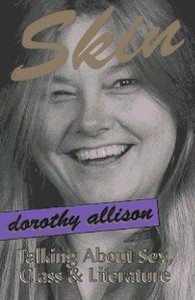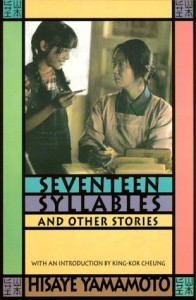 The world is conspiring to make me a feminist and I’m realizing how sadly overdue that evolution is. I had to become a writer before I could love myself as a woman, and I had to do both before I could become a feminist. This week Dorothy Allison taught me about all of these identities.
The world is conspiring to make me a feminist and I’m realizing how sadly overdue that evolution is. I had to become a writer before I could love myself as a woman, and I had to do both before I could become a feminist. This week Dorothy Allison taught me about all of these identities.
I found Skin: Talking About Sex, Class & Literature by pure fate. I never read Bastard out of Carolina, but when I saw Skin at the used bookstore, the title spoke to a lot of things I’m thinking about. So I took it home and put it on the top of the to-read pile. I couldn’t wait to read it and it blew my mind.
“If you do not break out in that sweat of fear when you write, then you have not gone far enough.” – Dorothy Allison
I come from a house where the word feminist was used interchangeably (and as nastily) as dyke. Dorothy Allison is both a lesbian and a feminist, and I’m sorry to say that for many years both would have made me distance myself from her. Instead of chastening me for my ignorance, she writes her own frank assessment of the strengths and weaknesses of the two identities as movements. She helped me realize I bristled at some aspects and judgments and not at the identities themselves.
My friend Liza (who is as reasonable and wise as Allison) wrote a brilliant post tying Juneteenth and the recent banning of State Rep. Lisa Brown for saying the word vagina. She advocates for equality of all people. How can we speak our truth when we can’t even name our body parts? Are we that repressed? Yes. We are.
I’m getting interested in the sex positive movement and the idea that whatever consenting adults choose to do is healthy. In the US, images of bodies are almost always sexualized and that makes it difficult to normalize our own. As a curious kid, I couldn’t look naturally at other bodies to see if what was happening to mine was normal (the drawings in sex ed answer so little). I had to resort to Playboy to see what other women looked like naked. Unfortunately those images taught me many other lessons that have been hard to shake.
Over the weekend, I visited Seattle’s Erotic Art Festival. I thought I would be surrounded by raunchy art that would leave me blushing and tittering behind my hand. Instead, I saw films and art that spoke to the simple, human sexuality in all of us. I started to wonder when I got so far away from the idea of myself as a sexual being. My next book is in some ways about the struggle to see myself that way.
“Writing is still revolutionary, writing is still about changing the world…You may not be happy as writers…but you will know who you are and you will change the world.” – Dorothy Allison
In one of her essays, Allison exhorts her reader, “Tell the truth. Write the story you were always afraid to tell. I swear to you there is magic in it, and if you show yourself naked for me, I’ll be naked for you. It will be our covenant.” I can’t think of better encouragement.
 Family tension seethes under the surface of the title story of Hisaye Yamamoto’s story collection Seventeen Syllables. Mrs. Hayashi has given up her passions long ago for a life of quiet suffering. When she discovers an interest in and a talent for haiku, she adds heat to the simmering boil of her family life. And yet Yamamoto conveys the initial familial tension and ensuing boil over through the careful, almost quiet, use of displaced description and contrast.
Family tension seethes under the surface of the title story of Hisaye Yamamoto’s story collection Seventeen Syllables. Mrs. Hayashi has given up her passions long ago for a life of quiet suffering. When she discovers an interest in and a talent for haiku, she adds heat to the simmering boil of her family life. And yet Yamamoto conveys the initial familial tension and ensuing boil over through the careful, almost quiet, use of displaced description and contrast.